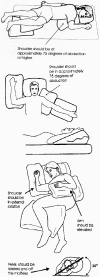Preservation of upper limb function following spinal cord injury: a clinical practice guideline for health-care professionals
- PMID: 16869091
- PMCID: PMC1808273
- DOI: 10.1080/10790268.2005.11753844
Preservation of upper limb function following spinal cord injury: a clinical practice guideline for health-care professionals
Figures





References
-
- Aljure J., Eltorai I., Bradley W.E., Lin J.E., Johnson B. Carpal tunnel syndrome in paraplegic patients. Paraplegia. 1985;23:182–6. - PubMed
-
- American College of Sports Medicine. Position stand: the recommended quantity and quality of exercise for developing and maintaining cardiorespiratory and muscular fitness and flexibility in healthy adults. Medicine & Science in Sports & Expercise. 1998;30:975–91. (Adjusted Rating–6) - PubMed
-
- Andersen J.H., Kaergaard A., Frost P., Thomsen J.F., Bonde J.P., Fallentin N., Borg V., Mikkelsen S. Physical, psychosocial, and individual risk factors for neck/shoulder pain with pressure tenderness in the muscles among workers performing monotonous, repetitive work. Spine. 2002;27:660–7. (Adjusted Rating–6) - PubMed
-
- Anderson B., Bornell D.G. Stretch and Strengthen for Rehabilitation and Development. Palmer Lake, CO: Stretching, Inc.; 1987. (Adjusted Rating–6)
-
- Armstrong T.J., Chaffin D.B. Carpal tunnel syndrome and selected personal attributes. Journal of Occupational Medicine. 1979;21:481–6. (Adjusted Rating–4) - PubMed
Publication types
MeSH terms
LinkOut - more resources
Full Text Sources
Medical
